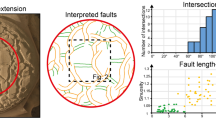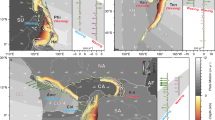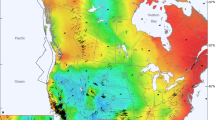Abstract
THE boundaries between the rigid plates which make up the Earth's crust are recognized as being of three distinct kinds: ridges, from which new crustal material spreads symmetrically ; trenches, at which plates descend back into the mantle ; transform faults, along which plates may slip relative to each other1–5. An important concept is the triple junction6, which is the point at which three plate boundaries meet. Discussions of the development of oceanic and continental crustal features almost inevitably contain considerations of motion, stability and instability of triple junctions. McKenzie and Morgan6 showed there are sixteen possible triple junctions and set out rules for examining their stability. They concluded that fourteen of them were stable under certain conditions. Here I point out that fifteen of the triple junctions are stable in the appropriate conditions.
This is a preview of subscription content, access via your institution
Access options
Subscribe to this journal
Receive 51 print issues and online access
$199.00 per year
only $3.90 per issue
Buy this article
- Purchase on Springer Link
- Instant access to full article PDF
Prices may be subject to local taxes which are calculated during checkout
Similar content being viewed by others
References
McKenzie, D. P., and Parker, R. L., Nature, 216, 1276 (1967).
Morgan, W. J., J. geophys. Res., 73, 1959 (1968).
Le Pichon, X., J. geophys. Res., 73, 3661 (1968).
Isacks, B., Oliver, J., and Sykes, L. R., J. geophys. Res., 73, 5855 (1968).
Wilson, J. T., Nature, 207, 343 (1965).
McKenzie, D. P., and Morgan, W. J., Nature, 224, 125 (1969).
Author information
Authors and Affiliations
Rights and permissions
About this article
Cite this article
YORK, D. Evolution of Triple Junctions. Nature 244, 341–342 (1973). https://doi.org/10.1038/244341a0
Received:
Issue Date:
DOI: https://doi.org/10.1038/244341a0
This article is cited by
-
Agulhas Basin magnetic bight
Nature (1980)
-
Stability of quadruple junctions
Nature (1979)
Comments
By submitting a comment you agree to abide by our Terms and Community Guidelines. If you find something abusive or that does not comply with our terms or guidelines please flag it as inappropriate.



